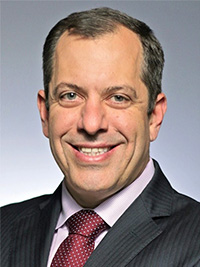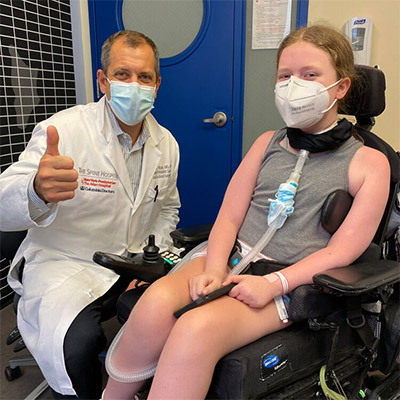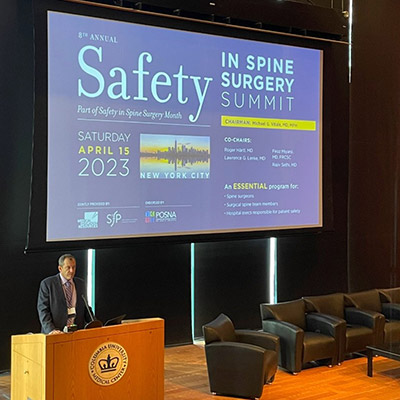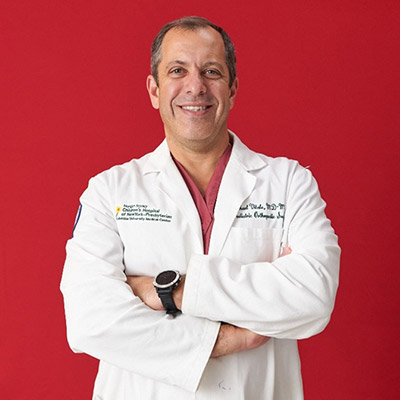Over the course of his renowned 23-year career, pediatric spine surgeon Dr. Michael Vitale has performed thousands of scoliosis surgeries, published more than 250 peer-reviewed research papers, and served in numerous leadership and governance roles in his field.
Michael G. Vitale, Orthopedic Surgeon at Columbia
But at the heart of his accomplishments is his commitment to patients. As a doctor who specializes in both the operative and non-operative treatment of complex scoliosis cases, Dr. Vitale often starts seeing many of his patients when they are very young. The long-term relationships he develops with his pediatric patients and their families are what motivates him in his work as a doctor, researcher, and advocate for patient safety.
“I really feel like I have a sacred obligation to my patients,” says Dr. Vitale, Chief of Pediatric Orthopedic Surgery at NewYork-Presbyterian and the Ana Lucia Professor of Pediatric Orthopedic Surgery at Columbia University Vagelos College of Physicians and Surgeons. “That means doing all that I can do to make myself the best at what I do, and also having the best place, system, and team to take care of these kids.”
Below, Dr. Vitale shares his thoughts on his pioneering work in spine surgery and patient safety, innovations in scoliosis treatment, and building a professional community around knowledge-sharing.
How did you decide on orthopedics as your career path in medicine?
My dad was an orthopedic surgeon. He practiced in Brooklyn for 50 years until just a year or two ago, so he was obviously an early influence on my career choice. Then I came to medical school at Columbia and met my previous boss and mentor, Dr. David Roye, who was a pediatric spine surgeon in the division before me. You get influenced by people you respect and who you see having fun, making an impact, and making people better. They were the two big early career influences in my life.
What do you think is the key to working with pediatric patients? How do you ensure that kids feel heard and understood?
I usually meet my patients early in their lives, follow them through a period, and sometimes end up operating on them, so you get to know the families well. The kids are usually anxious and sometimes they don’t really understand what's going on, so I think it's really important to connect with them, and at the same time understand that you have anxious parents who are worried about what's happening. You have to be attentive to the needs of everyone in the room.
I think one mistake people often make is not understanding how much kids think about what’s happening and how cognizant they are of their health issues and challenges. For example, I have a patient named Greta, who I treated for severe scoliosis caused by nemaline myopathy, a rare muscle disease. Particularly for a kid like her, who was already on a ventilator at a young age, it’s easy to make the mistake of thinking she’s not part of the conversation. But it’s actually the opposite when you interact with her. She’s a very dynamic, smart kid who is now focused on helping other kids with disabilities navigate their challenges. She’s always shown me that she has a much more mature perspective than maybe the average teenager would.
Dr. Vitale and patient Greta Baier, an NYC teenager with nemaline myopathy
As part of your work giving children a voice in their care, you and your colleagues created an early-onset scoliosis questionnaire for older children and adolescents to complete so they can self-report on quality-of-life factors. Why did you feel research in this area was needed?
We do a lot of research looking at the quality of life of the kids that we treat for early onset scoliosis and how our intervention, whether it’s bracing or something surgical, affects that. And in our work in this space, we know that patients have different preferences for health states; sometimes those preferences are different for the child versus the family.
I’m a father to teenage boys, so I know teenagers aren’t always willing to be open and share. They may not even be aware of what’s bothering them. It takes a level of trust and attention to understand the things that are important to a teen. Although this is research, it also informs our clinical decision-making and our perspective on what's best for various patients. The measures we’ve developed have been validated and translated, and the questionnaire is now in 12 languages and used all over the world.
Patient safety has been another passion of yours. In 2014 you helped launch the Safety in Spine Surgery Project (S3P) to develop best practices in spine surgical treatment. How did this come about?
For the most part, I take care of kids with very significant spine problems, which comes with some inherent risk, and many of these kids have other medical problems. I’m well aware of how lucky I am to practice at a place like NewYork-Presbyterian Morgan Stanley Children's Hospital, where I'm surrounded by the best of the best in every specialty. It allows me to do things that may not be so easy or possible elsewhere.
The reality is that my ability to navigate towards the best outcome has partly to do with my experience and what I can do technically in the operating room, and a lot to do with the whole system of care. That's where the field of patient safety has evolved to; we understand that the system’s approach is a critical part of making people better, avoiding medical error, and minimizing complications.
I’ve been interested in the area of quality for some time. In 2008, after we had a number of spine infections, I convened an internal expert panel early on to help us think through best practices and what we could do better to lower infection rates using formally derived expert opinion and specific consensus-building techniques. We developed guidelines very early on that became nationally adopted. People all over the country were calling me saying, “Your checklist helped me avoid a problem. I want to thank you.”
Dr. Vitale presenting at the 8th Annual Safety In Spine Surgery Summit in 2023
Those were the early efforts that gave birth to the Project for Safety in Spine Surgery and our annual Spine Safety Summit. Every year we develop a different best-practice guideline. We have guidelines around wrong-level spine surgery; optimum practice for conservative scoliosis care; and how best to treat patients who need halo-gravity traction, among other things. We realized that the thirst for and the potential impact of this type of work was much bigger, and we needed to figure out a way to scale it and disseminate it. Our summits now draw surgeons, nurses, and administrators from all over the world.
You describe your treatment approach as conservative, but you were also the first doctor in New York City to treat early-onset scoliosis using magnetic growing rods (a technique that allows for nonsurgical lengthening of the spine using magnets). What’s your approach to adopting new treatment methods?
I have a very conservative approach in that, whenever we can avoid surgery, it’s better to avoid surgery. We have a Center for Conservative Care for Spine and Scoliosis where we have amazing physical therapists who are trained in conservative treatment. We do a lot of research in this space, have pioneered new techniques in bracing, and have new understandings of three-dimensional bracing. Because first and foremost, your job is to take care of the patient, not to operate.
Michael G. Vitale, Chief of Pediatric Spine Surgery at NewYork-Presbyterian/
But when you’re talking about the balance between innovation, new technologies, and safety, I don't really look at myself as an early adopter. I think I'm consciously an early-middle adopter because it takes some time to figure out what the true outcomes and true risks are. New technologies, by virtue of them being new, don’t make them better or safer. That doesn’t mean technology is not positive or advantageous. It just means in the beginning, you don’t know the true outcomes, and it can take time to understand what’s working and what isn’t.
That’s why in the past I’ve run a national study group called the Pediatric Spine Study Group. We have the biggest collection of patients with spine problems in the world, and they all happen to be under 10 years of age. That allows us to accelerate our understanding of new technologies. So by the time I had used magnetic rods, there was extensive international and national experience around it, and I felt confident it was the right thing.
At the end of the day, what do you hope patients and colleagues would say about working with you?
That everything I do is part of my sacred obligation to the kids. Because unfortunately, what we do is hard in lots of ways, and some of the things that we treat don't have solutions that are perfect. But I personally couldn't go on doing what I do without feeling that in every way, I'm trying to mobilize the whole slew of possibilities in modern medicine for the patient.
And on a professional level, I feel really fortunate to be where I am and to have the teams that I have helping me scale the patient quality work and clinical research. I feel an obligation to do that because at the end of the day, I think you have to take advantage of the opportunities you have to make a difference on a larger scale. I think every single thing that we do as doctors in this field, every single decision, every single choice, every single priority, has to be focused on taking the best care of kids, and then helping others do the same.







